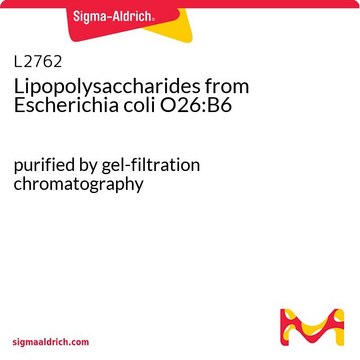L2143
Lipopolysaccharides from Escherichia coli K-235
purified by phenol extraction
Sinónimos:
LPS
About This Item
Productos recomendados
origen biológico
Escherichia coli (K-235)
Nivel de calidad
formulario
lyophilized powder
purificado por
phenol extraction
impurezas
<3% Protein (Lowry)
color
white to faint yellow
solubilidad
water: soluble
Condiciones de envío
ambient
temp. de almacenamiento
2-8°C
¿Está buscando productos similares? Visita Guía de comparación de productos
Descripción general
Aplicación
- Establishment of disseminated intravascular coagulation (DIC) model by a single iv administration of Escherichia coli-derived lipopolysaccharide (LPS) to cynomolgus monkeys and evaluation of its pathophysiological status.: This study established a DIC model in cynomolgus monkeys using E. coli-derived LPS, providing insights into the pathophysiological status and potential therapeutic interventions for DIC (Minomo et al., 2017).
- Different bacterial lipopolysaccharides as toxicants and stressors in the shrimp Palaemon elegans.: This research explored the toxic effects of various bacterial LPS, including E. coli K-235, on the shrimp Palaemon elegans, advancing the understanding of LPS-induced stress responses in marine organisms (Lorenzon et al., 2002).
Acciones bioquímicas o fisiológicas
Nota de preparación
Otras notas
Producto relacionado
Palabra de señalización
Danger
Frases de peligro
Consejos de prudencia
Clasificaciones de peligro
Acute Tox. 2 Oral
Código de clase de almacenamiento
6.1A - Combustible acute toxic Cat. 1 and 2 / very toxic hazardous materials
Clase de riesgo para el agua (WGK)
WGK 3
Punto de inflamabilidad (°F)
Not applicable
Punto de inflamabilidad (°C)
Not applicable
Equipo de protección personal
Eyeshields, Gloves, type N95 (US)
Certificados de análisis (COA)
Busque Certificados de análisis (COA) introduciendo el número de lote del producto. Los números de lote se encuentran en la etiqueta del producto después de las palabras «Lot» o «Batch»
¿Ya tiene este producto?
Encuentre la documentación para los productos que ha comprado recientemente en la Biblioteca de documentos.
Los clientes también vieron
Nuestro equipo de científicos tiene experiencia en todas las áreas de investigación: Ciencias de la vida, Ciencia de los materiales, Síntesis química, Cromatografía, Analítica y muchas otras.
Póngase en contacto con el Servicio técnico

